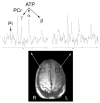Brain-mapping techniques for evaluating poststroke recovery and rehabilitation: a review
- PMID: 19008203
- PMCID: PMC2663338
- DOI: 10.1310/tsr1505-427
Brain-mapping techniques for evaluating poststroke recovery and rehabilitation: a review
Abstract
Brain-mapping techniques have proven to be vital in understanding the molecular, cellular, and functional mechanisms of recovery after stroke. This article briefly summarizes the current molecular and functional concepts of stroke recovery and addresses how various neuroimaging techniques can be used to observe these changes. The authors provide an overview of various techniques including diffusion-tensor imaging (DTI), magnetic resonance spectroscopy (MRS), ligand-based positron emission tomography (PET), single-photon emission computed tomography (SPECT), regional cerebral blood flow (rCBF) and regional metabolic rate of glucose (rCMRglc) PET and SPECT, functional magnetic resonance imaging (fMRI), near infrared spectroscopy (NIRS), electroencephalography (EEG), magnetoencephalography (MEG), and transcranial magnetic stimulation (TMS). Discussion in the context of poststroke recovery research informs about the applications and limitations of the techniques in the area of rehabilitation research. The authors also provide suggestions on using these techniques in tandem to more thoroughly address the outstanding questions in the field.
Figures




References
-
- Rosamond W, Flegal K, Furie K, et al. Heart disease and stroke statistics—2008 update: A report from the American Heart Association Statistics Committee and Stroke Statistics Subcommittee. Circulation. 2008;117:e25–146. - PubMed
-
- Nudo RJ. Mechanisms for recovery of motor function following cortical damage. Curr Opin Neurobiol. 2006;16:638–644. - PubMed
-
- Nudo RJ. Postinfarct cortical plasticity and behavioral recovery. Stroke. 2007;38:840–845. - PubMed
-
- Carmichael ST. Cellular and molecular mechanisms of neural repair after stroke: Making waves. Ann Neurol. 2006;59:735–742. - PubMed
-
- Carmichael ST, Archibeque I, Luke L, Nolan T, Momiy J, Li S. Growth-associated gene expression after stroke: Evidence for a growth-promoting region in periinfarct cortex. Exp Neurol. 2005;193:291–311. - PubMed
Publication types
MeSH terms
Grants and funding
LinkOut - more resources
Full Text Sources
Medical
